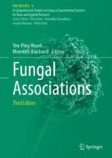Search
Search Results
-
In vitro resynthesis of lichenization reveals the genetic background of symbiosis-specific fungal-algal interaction in Usnea hakonensis
BackgroundSymbiosis is central to ecosystems and has been an important driving force of the diversity of life. Close and long-term interactions are...

-
Lichens and Their Allies Past and Present
This chapter gives an overview on (1) lichen-forming fungi, lichen photobionts and peculiarities of lichen symbiosis such as gains and losses of...
-
The effects of co-culture on the expression of selected PKS genes in the lichenized fungus Xanthoparmelia taractica
Lichens produce diverse secondary metabolites. A diversity of these compounds is synthesized by fungal polyketide synthases (PKSs). In this study, we...

-
Umbilicaria muhlenbergii: A Model for Studying Molecular Mechanisms Regulating Initial Fungal Symbiotic Interactions with Algal Cells
Lichens are known for their importance in evolution and ecology but our knowledge of molecular mechanisms regulating symbiont interactions in lichen...
-
Lichens
Lichenized fungi initiate their symbiotic structures from microscopic stages after recognition of compatible algae. The partnerships ultimately...
-
Stable transformation of the unicellular lichenic green alga Coccomyxa solorinae-saccatae via electroporation
In this study, we have demonstrated the applicability of electroporation for the stable nuclear transformation of Coccomyxa solorinae-saccatae . An...

-
Evolution of non-lichenized, saprotrophic species of Arthonia (Ascomycota, Arthoniales) and resurrection of Naevia, with notes on Mycoporum
Fungi that are barely lichenized or non-lichenized and closely related to lichenized taxa, the so-called borderline fungi, are an important element...

-
Fungal community inside lichen: a curious case of sparse diversity and high modularity
BackgroundLichens represent not only the mutualism of fungal and photosynthetic partners but also are composed of microbial consortium harboring...

-
Symbioses
This chapter treats the various forms of symbioses between several organism groups with cyanobacteria and algae. A separate sub-chapter highlights...
-
Unpigmented lichen substances protect lichens against photoinhibition of photosystem II in both the hydrated and desiccated states
Lichen secondary metabolites have been suggested to play a great diversity of roles in lichen biology by acting as UV screens, antimicrobials,...

-

-
Phototrophic Mats of the Desert: The Bacteria of the Biological Soil Crust Community
Biological soil crusts (biocrusts) are surface soil communities that can be made up of cyanobacteria, lichens, heterotrophic bacteria, archaea,...
-
The lichen symbiosis re-viewed through the genomes of Cladonia grayi and its algal partner Asterochloris glomerata
BackgroundLichens, encompassing 20,000 known species, are symbioses between specialized fungi (mycobionts), mostly ascomycetes, and unicellular green...

-
How do genes flow? Identifying potential dispersal mode for the semi-aquatic lichen Dermatocarpon luridum using spatial modelling and photobiont markers
BackgroundLandscape genetics is an interdisciplinary field that combines tools and techniques from population genetics with the spatially explicit...

-
Bryoclavula phycophila gen. et sp. nov. belonging to a novel lichenized lineage in Cantharellales (Basidiomycota)
A new clavarioid, lichenized basidiomycete, Bryoclavula phycophila gen. et sp. nov., is described from Japan based on morphological observations and...

-
Cyphellostereum ushimanum sp. nov. (Hygrophoraceae, Agaricales) described from Amami-Oshima Island (Kagoshima Prefecture, Ryukyu Islands), Japan, with ultrastructural observations of its Rhizonema photobiont filaments penetrated longitudinally by a central haustorium
We collected a resupinate fungus lichenized with filamentous Rhizonema cyanobacteria in Amami-Oshima Island, Japan. Microscopic observations and...

-
Genomic and fossil windows into the secret lives of the most ancient fungi
Fungi have crucial roles in modern ecosystems as decomposers and pathogens, and they engage in various mutualistic associations with other organisms,...

-
Himantormia lugubris, an Antarctic endemic on the edge of the lichen symbiosis
Himantormia lugubris is an Antarctic endemic with a distribution restricted to the northwest tip of Antarctic Peninsula, adjacent islands and South...

-
Phytohormone release by three isolated lichen mycobionts and the effects of indole-3-acetic acid on their compatible photobionts
Evidence is emerging that phytohormones represent key inter-kingdom signalling compounds supporting chemical communication between plants, fungi and...

-
The Bacterial Community of the Foliose Macro-lichen Peltigera frigida Is More than a Mere Extension of the Microbiota of the Subjacent Substrate
Lichens host highly diverse microbial communities, with bacteria being one of the most explored groups in terms of their diversity and functioning....

